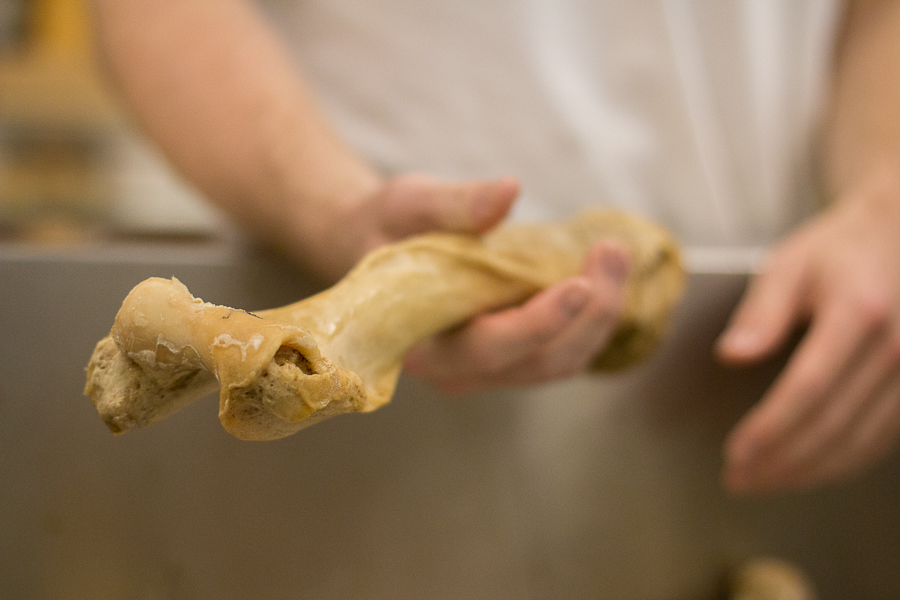
Bear bones are cleaned in UC Davis’ Zooarchaeology Lab.
Aside from cleaning your clothes, it turns out laundry detergent is useful in cleaning bear bones. This idea seems strange, but it is just another ordinary day in the zooarchaeology lab.
The lab’s current project is cleaning a bear skeleton that was donated by Girl Scouts Heart of Central California, the local Girl Scout chapter.
“It looks gross but it’s a lot of fun,” said Ryan Gallagher, a fourth-year physical anthropology major and an intern in the zooarchaeology lab.
The department hosts a collection of more than 1800 different specimens, which includes fish, reptiles, birds and mammals. They process about five sets of remains per year for teaching and research purposes.
Dr. Christyann Darwent is a zooarchaeologist at UC Davis and studies the animal remains recovered from archaeological sites.
“These specimens are used to help identify animal bones from archaeological sites,” Darwent said.
Animal remains, such as skulls and bones, are donated to the department from various sources. Friends of the department have given roadkill or skeletons they have found while hiking. I worked as a counselor at the Girl Scouts’ summer camp and facilitated the transfer of the bear bones to the lab.
Maintenance staff came across the remains while inspecting a Girl Scout property near Placerville last February. The bear skeleton was then brought to the main camp in Calaveras County, so that staff members could use it as a teaching tool.
“Being able to touch and examine the bones gives girls who learn kinesthetically a chance to become engaged in the natural sciences,” said Kaitlyn Heb, a STEM specialist at the camp. “It gives the girls a chance to see something up close and personal that they would not be able to see in the city and get a point of view they might not get from a museum.”
All of the skin and muscle had decomposed from the bear, but the skeleton was covered in dirt, grease and fat. Despite camp counselors and campers being armed with unused toilet scrubbers and dish soap, the bones remained gross and little bit smelly.
To get dirt off the bones, I tried soaking them in warm soapy water a few times. The waste water was full of tissue and things I could not identify. One time, I was showing a group of campers what I was doing, and spilled the entire can of waste water on me. My socks, shoes- everything from the knees down was covered in bear juice. That was a mistake I never repeated.
I still used the bones as a teaching tool, and I showed the campers how the bones worked and fit together. The bear also had a really bad cavity, and we were able to get the children excited about seeing what tooth decay looked like up close.
“I hope we can talk through what information the bones can give us about the life it lived, how people that study animal bones can piece together information and learn more,” said Leah Traina, the associate camp director.
When the summer camp ended, the skeleton sat in boxes in my backyard until early January when it was taken to the lab. The Girl Scouts will be getting the bones back once Darwent and her interns have cleaned the skeleton.
“We actually use laundry detergent- powdered laundry detergent,” Darwent said.
The skeleton is about halfway through its soaking period of two weeks. In this time, the bones are placed in a pot with water and laundry detergent. Once the pot is covered, it is left to sit on a hot pad. When the water is changed out during the two weeks, bits of fat and tissue are seen floating around from the bones. Gallagher has worked on similar projects in the past.
“I’ve done a horse and helped with some pigs,” Gallagher said.
The horse, in particular, had not been cleaned at all before heading to the lab, which meant that it arrived with all of its flesh and muscle.
After its soak, the bones will be ‘polished up’ by removing leftover bits of dirt with a toothbrush. The teeth that have fallen out would also be glued back in. Since the Girl Scouts would be used as a teaching tool, the skeleton would then probably be bleached to ensure its cleanliness.
Most of the bones were found, aside from its sternum (chest area) and most of its paw bones.
“Bears are usually found pretty whole, scavengers won’t take the bones far,” Gallagher said.
There are two other bear skulls in the specimen collection that have an obvious cause of death; the massive bullet holes on the sides of their skulls are hard to miss. However, this bear does not have any bullet holes, and Darwent and Gallagher have not yet determined how it died.
Already Darwent has been able to identify key facts that campers were asking about the bear.
“Given it was found in California and based on the size of the skull I am certain it is a black bear,” Darwent said. “Sadly brown bears are extinct in California despite them being on the state flag. My guess [is it] would be female as no baculum [os penis] bone was recovered.”
Darwent estimates they will be done cleaning the bones before winter quarter is over. This will give the Girl Scouts more than enough time to establish the bear at its future home, the overnight camp in Calaveras County.
“It’s important to teach kids about nature so they feel comfortable interacting in the natural world,” Traina said.
Written by: Rachel Paul — science@theaggie.org



